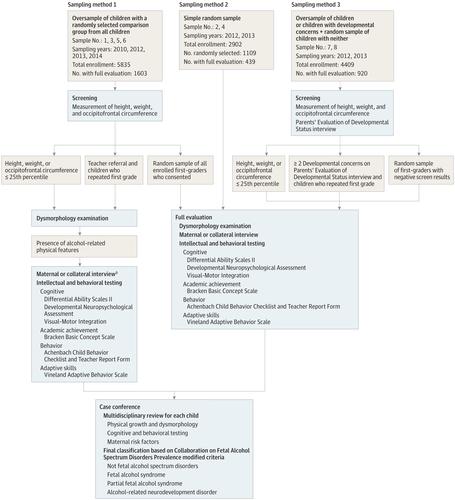Our official English website, www.x-mol.net, welcomes your
feedback! (Note: you will need to create a separate account there.)
Prevalence of Fetal Alcohol Spectrum Disorders in 4 US Communities
JAMA ( IF 63.1 ) Pub Date : 2018-02-06 , DOI: 10.1001/jama.2017.21896 Philip A. May 1, 2 , Christina D. Chambers 3, 4 , Wendy O. Kalberg 2 , Jennifer Zellner 3 , Haruna Feldman 3 , David Buckley 2 , David Kopald 3 , Julie M. Hasken 1 , Ronghui Xu 3 , Gordon Honerkamp-Smith 3 , Howard Taras 3 , Melanie A. Manning 5 , Luther K. Robinson 6 , Margaret P. Adam 7 , Omar Abdul-Rahman 8 , Keith Vaux 3 , Tamison Jewett 9 , Amy J. Elliott 10 , Julie A. Kable 11 , Natacha Akshoomoff 3 , Daniel Falk 12 , Judith A. Arroyo 12 , Dale Hereld 12 , Edward P. Riley 13 , Michael E. Charness 14, 15, 16 , Claire D. Coles 11 , Kenneth R. Warren 12 , Kenneth Lyons Jones 3, 4 , H. Eugene Hoyme 17, 18
JAMA ( IF 63.1 ) Pub Date : 2018-02-06 , DOI: 10.1001/jama.2017.21896 Philip A. May 1, 2 , Christina D. Chambers 3, 4 , Wendy O. Kalberg 2 , Jennifer Zellner 3 , Haruna Feldman 3 , David Buckley 2 , David Kopald 3 , Julie M. Hasken 1 , Ronghui Xu 3 , Gordon Honerkamp-Smith 3 , Howard Taras 3 , Melanie A. Manning 5 , Luther K. Robinson 6 , Margaret P. Adam 7 , Omar Abdul-Rahman 8 , Keith Vaux 3 , Tamison Jewett 9 , Amy J. Elliott 10 , Julie A. Kable 11 , Natacha Akshoomoff 3 , Daniel Falk 12 , Judith A. Arroyo 12 , Dale Hereld 12 , Edward P. Riley 13 , Michael E. Charness 14, 15, 16 , Claire D. Coles 11 , Kenneth R. Warren 12 , Kenneth Lyons Jones 3, 4 , H. Eugene Hoyme 17, 18
Affiliation

|
Importance Fetal alcohol spectrum disorders are costly, life-long disabilities. Older data suggested the prevalence of the disorder in the United States was 10 per 1000 children; however, there are few current estimates based on larger, diverse US population samples. Objective To estimate the prevalence of fetal alcohol spectrum disorders, including fetal alcohol syndrome, partial fetal alcohol syndrome, and alcohol-related neurodevelopmental disorder, in 4 regions of the United States. Design, Setting, and Participants Active case ascertainment methods using a cross-sectional design were used to assess children for fetal alcohol spectrum disorders between 2010 and 2016. Children were systematically assessed in the 4 domains that contribute to the fetal alcohol spectrum disorder continuum: dysmorphic features, physical growth, neurobehavioral development, and prenatal alcohol exposure. The settings were 4 communities in the Rocky Mountain, Midwestern, Southeastern, and Pacific Southwestern regions of the United States. First-grade children and their parents or guardians were enrolled. Exposures Alcohol consumption during pregnancy. Main Outcomes and Measures Prevalence of fetal alcohol spectrum disorders in the 4 communities was the main outcome. Conservative estimates for the prevalence of the disorder and 95% CIs were calculated using the eligible first-grade population as the denominator. Weighted prevalences and 95% CIs were also estimated, accounting for the sampling schemes and using data restricted to children who received a full evaluation. Results A total of 6639 children were selected for participation from a population of 13 146 first-graders (boys, 51.9%; mean age, 6.7 years [SD, 0.41] and white maternal race, 79.3%). A total of 222 cases of fetal alcohol spectrum disorders were identified. The conservative prevalence estimates for fetal alcohol spectrum disorders ranged from 11.3 (95% CI, 7.8-15.8) to 50.0 (95% CI, 39.9-61.7) per 1000 children. The weighted prevalence estimates for fetal alcohol spectrum disorders ranged from 31.1 (95% CI, 16.1-54.0) to 98.5 (95% CI, 57.5-139.5) per 1000 children. Conclusions and Relevance Estimated prevalence of fetal alcohol spectrum disorders among first-graders in 4 US communities ranged from 1.1% to 5.0% using a conservative approach. These findings may represent more accurate US prevalence estimates than previous studies but may not be generalizable to all communities.
中文翻译:

美国 4 个社区胎儿酒精谱系障碍的患病率
重要性 胎儿酒精谱系障碍是代价高昂的终身残疾。较早的数据表明,这种疾病在美国的患病率为每 1000 名儿童中有 10 人;然而,目前很少有基于更大的、多样化的美国人口样本的估计。目的 估计美国 4 个地区胎儿酒精谱系障碍的患病率,包括胎儿酒精综合征、部分胎儿酒精综合征和酒精相关神经发育障碍。设计、设置和参与者 使用横断面设计的主动病例确定方法用于评估 2010 年至 2016 年间胎儿酒精谱系障碍的儿童。在导致胎儿酒精谱系障碍连续体的 4 个领域对儿童进行系统评估:畸形特征,身体发育,神经行为发育和产前酒精暴露。设置为美国落基山、中西部、东南部和太平洋西南部地区的 4 个社区。一年级的孩子和他们的父母或监护人都被录取了。暴露 在怀孕期间饮酒。主要结果和措施 4 个社区胎儿酒精谱系障碍的患病率是主要结果。使用符合条件的一年级人口作为分母计算该疾病患病率和 95% CI 的保守估计值。还估计了加权流行率和 95% CI,考虑到抽样方案并使用仅限于接受全面评估的儿童的数据。结果在13 146名一年级学生(男生51.9%;平均年龄,6.7 岁 [SD,0.41] 和白人母亲种族,79.3%)。共确定了 222 例胎儿酒精谱系障碍。胎儿酒精谱系障碍的保守患病率估计范围为每 1000 名儿童 11.3(95% CI,7.8-15.8)至 50.0(95% CI,39.9-61.7)。胎儿酒精谱系障碍的加权患病率估计值为每 1000 名儿童 31.1(95% CI,16.1-54.0)至 98.5(95% CI,57.5-139.5)。结论和相关性 使用保守方法估计美国 4 个社区一年级学生中胎儿酒精谱系障碍的患病率范围为 1.1% 至 5.0%。这些发现可能代表比以前研究更准确的美国流行率估计,但可能无法推广到所有社区。共确定了 222 例胎儿酒精谱系障碍。胎儿酒精谱系障碍的保守患病率估计范围为每 1000 名儿童 11.3(95% CI,7.8-15.8)至 50.0(95% CI,39.9-61.7)。胎儿酒精谱系障碍的加权患病率估计值为每 1000 名儿童 31.1(95% CI,16.1-54.0)至 98.5(95% CI,57.5-139.5)。结论和相关性 使用保守方法估计美国 4 个社区一年级学生中胎儿酒精谱系障碍的患病率范围为 1.1% 至 5.0%。这些发现可能代表比以前研究更准确的美国流行率估计,但可能无法推广到所有社区。共确定了 222 例胎儿酒精谱系障碍。胎儿酒精谱系障碍的保守患病率估计范围为每 1000 名儿童 11.3(95% CI,7.8-15.8)至 50.0(95% CI,39.9-61.7)。胎儿酒精谱系障碍的加权患病率估计值为每 1000 名儿童 31.1(95% CI,16.1-54.0)至 98.5(95% CI,57.5-139.5)。结论和相关性 使用保守方法估计美国 4 个社区一年级学生中胎儿酒精谱系障碍的患病率范围为 1.1% 至 5.0%。这些发现可能代表比以前的研究更准确的美国流行率估计,但可能无法推广到所有社区。8) 到 50.0 (95% CI, 39.9-61.7) 每 1000 名儿童。胎儿酒精谱系障碍的加权患病率估计值为每 1000 名儿童 31.1(95% CI,16.1-54.0)至 98.5(95% CI,57.5-139.5)。结论和相关性 使用保守方法估计美国 4 个社区一年级学生中胎儿酒精谱系障碍的患病率范围为 1.1% 至 5.0%。这些发现可能代表比以前的研究更准确的美国流行率估计,但可能无法推广到所有社区。8) 到 50.0 (95% CI, 39.9-61.7) 每 1000 名儿童。胎儿酒精谱系障碍的加权患病率估计值为每 1000 名儿童 31.1(95% CI,16.1-54.0)至 98.5(95% CI,57.5-139.5)。结论和相关性 使用保守方法估计美国 4 个社区一年级学生中胎儿酒精谱系障碍的患病率范围为 1.1% 至 5.0%。这些发现可能代表比以前研究更准确的美国流行率估计,但可能无法推广到所有社区。结论和相关性 使用保守方法估计美国 4 个社区一年级学生中胎儿酒精谱系障碍的患病率范围为 1.1% 至 5.0%。这些发现可能代表比以前研究更准确的美国流行率估计,但可能无法推广到所有社区。结论和相关性 使用保守方法估计美国 4 个社区一年级学生中胎儿酒精谱系障碍的患病率范围为 1.1% 至 5.0%。这些发现可能代表比以前研究更准确的美国流行率估计,但可能无法推广到所有社区。
更新日期:2018-02-06
中文翻译:

美国 4 个社区胎儿酒精谱系障碍的患病率
重要性 胎儿酒精谱系障碍是代价高昂的终身残疾。较早的数据表明,这种疾病在美国的患病率为每 1000 名儿童中有 10 人;然而,目前很少有基于更大的、多样化的美国人口样本的估计。目的 估计美国 4 个地区胎儿酒精谱系障碍的患病率,包括胎儿酒精综合征、部分胎儿酒精综合征和酒精相关神经发育障碍。设计、设置和参与者 使用横断面设计的主动病例确定方法用于评估 2010 年至 2016 年间胎儿酒精谱系障碍的儿童。在导致胎儿酒精谱系障碍连续体的 4 个领域对儿童进行系统评估:畸形特征,身体发育,神经行为发育和产前酒精暴露。设置为美国落基山、中西部、东南部和太平洋西南部地区的 4 个社区。一年级的孩子和他们的父母或监护人都被录取了。暴露 在怀孕期间饮酒。主要结果和措施 4 个社区胎儿酒精谱系障碍的患病率是主要结果。使用符合条件的一年级人口作为分母计算该疾病患病率和 95% CI 的保守估计值。还估计了加权流行率和 95% CI,考虑到抽样方案并使用仅限于接受全面评估的儿童的数据。结果在13 146名一年级学生(男生51.9%;平均年龄,6.7 岁 [SD,0.41] 和白人母亲种族,79.3%)。共确定了 222 例胎儿酒精谱系障碍。胎儿酒精谱系障碍的保守患病率估计范围为每 1000 名儿童 11.3(95% CI,7.8-15.8)至 50.0(95% CI,39.9-61.7)。胎儿酒精谱系障碍的加权患病率估计值为每 1000 名儿童 31.1(95% CI,16.1-54.0)至 98.5(95% CI,57.5-139.5)。结论和相关性 使用保守方法估计美国 4 个社区一年级学生中胎儿酒精谱系障碍的患病率范围为 1.1% 至 5.0%。这些发现可能代表比以前研究更准确的美国流行率估计,但可能无法推广到所有社区。共确定了 222 例胎儿酒精谱系障碍。胎儿酒精谱系障碍的保守患病率估计范围为每 1000 名儿童 11.3(95% CI,7.8-15.8)至 50.0(95% CI,39.9-61.7)。胎儿酒精谱系障碍的加权患病率估计值为每 1000 名儿童 31.1(95% CI,16.1-54.0)至 98.5(95% CI,57.5-139.5)。结论和相关性 使用保守方法估计美国 4 个社区一年级学生中胎儿酒精谱系障碍的患病率范围为 1.1% 至 5.0%。这些发现可能代表比以前研究更准确的美国流行率估计,但可能无法推广到所有社区。共确定了 222 例胎儿酒精谱系障碍。胎儿酒精谱系障碍的保守患病率估计范围为每 1000 名儿童 11.3(95% CI,7.8-15.8)至 50.0(95% CI,39.9-61.7)。胎儿酒精谱系障碍的加权患病率估计值为每 1000 名儿童 31.1(95% CI,16.1-54.0)至 98.5(95% CI,57.5-139.5)。结论和相关性 使用保守方法估计美国 4 个社区一年级学生中胎儿酒精谱系障碍的患病率范围为 1.1% 至 5.0%。这些发现可能代表比以前的研究更准确的美国流行率估计,但可能无法推广到所有社区。8) 到 50.0 (95% CI, 39.9-61.7) 每 1000 名儿童。胎儿酒精谱系障碍的加权患病率估计值为每 1000 名儿童 31.1(95% CI,16.1-54.0)至 98.5(95% CI,57.5-139.5)。结论和相关性 使用保守方法估计美国 4 个社区一年级学生中胎儿酒精谱系障碍的患病率范围为 1.1% 至 5.0%。这些发现可能代表比以前的研究更准确的美国流行率估计,但可能无法推广到所有社区。8) 到 50.0 (95% CI, 39.9-61.7) 每 1000 名儿童。胎儿酒精谱系障碍的加权患病率估计值为每 1000 名儿童 31.1(95% CI,16.1-54.0)至 98.5(95% CI,57.5-139.5)。结论和相关性 使用保守方法估计美国 4 个社区一年级学生中胎儿酒精谱系障碍的患病率范围为 1.1% 至 5.0%。这些发现可能代表比以前研究更准确的美国流行率估计,但可能无法推广到所有社区。结论和相关性 使用保守方法估计美国 4 个社区一年级学生中胎儿酒精谱系障碍的患病率范围为 1.1% 至 5.0%。这些发现可能代表比以前研究更准确的美国流行率估计,但可能无法推广到所有社区。结论和相关性 使用保守方法估计美国 4 个社区一年级学生中胎儿酒精谱系障碍的患病率范围为 1.1% 至 5.0%。这些发现可能代表比以前研究更准确的美国流行率估计,但可能无法推广到所有社区。











































 京公网安备 11010802027423号
京公网安备 11010802027423号